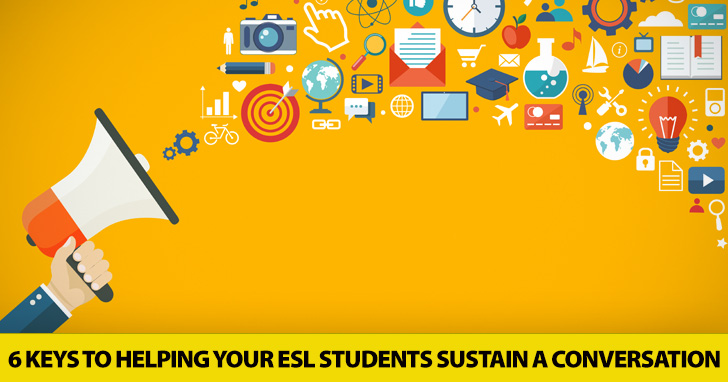8 Ways You Can Teach Less and Facilitate More


ESL students come from a variety of backgrounds and age groups. They have different needs, interests and face their own challenges when it comes to learning a second language. Yet they all have one essential thing in common. They all need to learn to sustain a clear, meaningful conversation in English. No matter how shy or how extroverted they are, no matter how young or how old, or whether they need to speak English to socialize or to work, they all need to learn to carry a conversation. It’s our job to guide them and so here are the six keys to helping them improve their conversations skills.

Some ESL students are too aware of the mistakes they make when they speak. In fact, they try so hard not to make any, it ends up affecting their ability to carry a conversation. There’s no need to launch into a lecture about the differences between accuracy and fluency, but you can try to communicate that:
As you progress through the course, clarify what is expected of them before you start each activity. Is this going to be a Q&A session where they need to try hard to use correct grammar in their answers? Or is it going to be a free-speaking activity where they need to focus on expressing their thoughts as best they can?
We spend a lot of time either teaching new grammar or new vocabulary, but for students to be able to sustain a conversation, it is absolutely essential for them to learn whole, set phrases, and practice their correct pronunciation and intonation. Examples of these include:
Be sure to teach a variety of phrases, while avoiding those that are too hard for them to pronounce (like “I wholeheartedly agree”).
ESL students are embarrassed enough by the mistakes they make without having to add awkward silences to the mix. And while it’s important for them to understand they should not be embarrassed by either, it’s also useful for them to have a handful of hesitation expressions they can quickly remember for those times when they need a few seconds to think and gather their thoughts. Because they will need those few seconds to articulate a good response. Some great hesitation expressions to teach include:
Students should understand that it’s okay to hesitate. Even native speakers do it, and it’s part of the natural flow of a conversation.
When two students are engaged in a conversation, corrections can be a very tricky business. On the one hand, if you interrupt them to correct a mistake, you may interrupt the natural flow of conversation. You may cause students to lose their train of thought. And you may affect their confidence in their speaking ability. On the other hand, if you don’t correct them, they could be making mistakes that might become fossilized.
The key lies in knowing when and how to correct. Take notes as your students speak and give them feedback after their conversation has ended. Don’t give them a list of every single mistake they made – once again their confidence will suffer. Group speaking mistakes into useful categories, like vocabulary they used wrong or words they mispronounced. This way you’re also increasing their odds of remembering what they need to work on.
In an ESL class, students’ fluency and speaking abilities range from those of the articulate conversationalist to the shy introvert who might mumble one-word answers. What happens if you pair these two very different types of speaker? Why one will dominate the conversation, of course, while the other might nod every now and then, and occasionally supply a “yes”, “no” or “maybe” reply. Now if we were to pair up students with a similar level of proficiency the conversation would get very interesting. And if we match two very shy students, we might need to give them a better preparation for the conversation, like ideas for expressions or vocabulary they can use, or ways to start/end the conversation. In either case, because the students are better matched, they will be working together towards a common speaking goal.
Some student conversations start out great and then slowly fizzle out till neither student knows what to say next. There is no need to let it come to that. Depending on the task or topic, give student pairs a time limit, say five minutes, for their discussion. This will force them to focus to get the task done, as they have a limited time to do so. It will help them practice how to organize their thoughts quickly, or they might find out they’ve run out of time.
Not everyone knows how to sustain a conversation – it can be hard for ESL students and native speakers alike. But it is our job to provide our students with the tools that will help them communicate better and more effectively.
How do you help your students sustain a conversation? Share in the comments below!